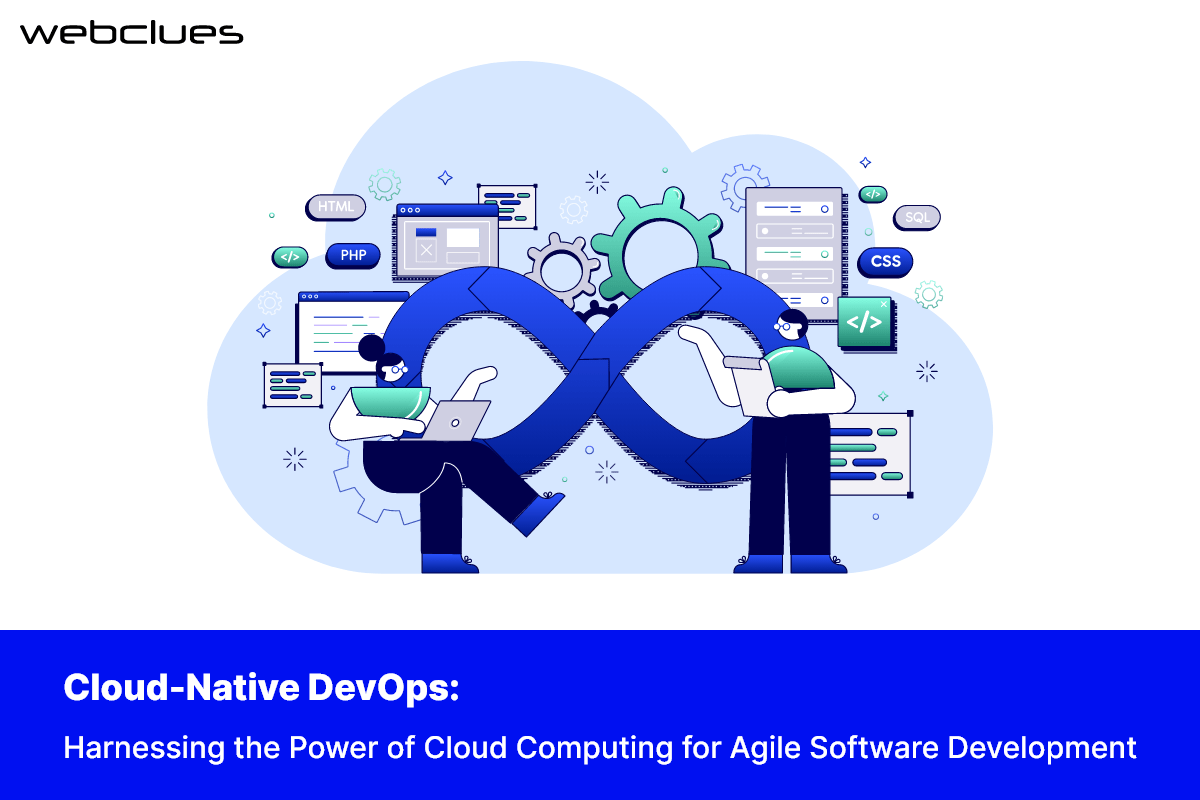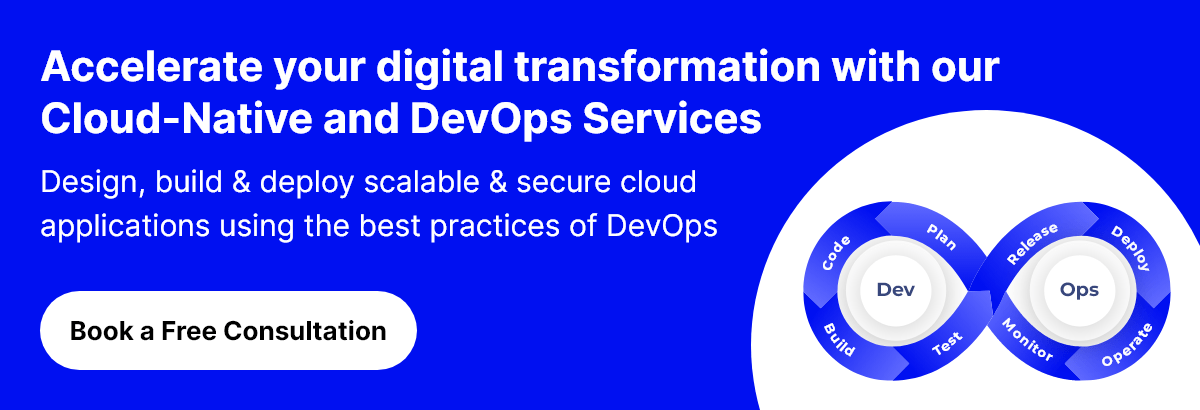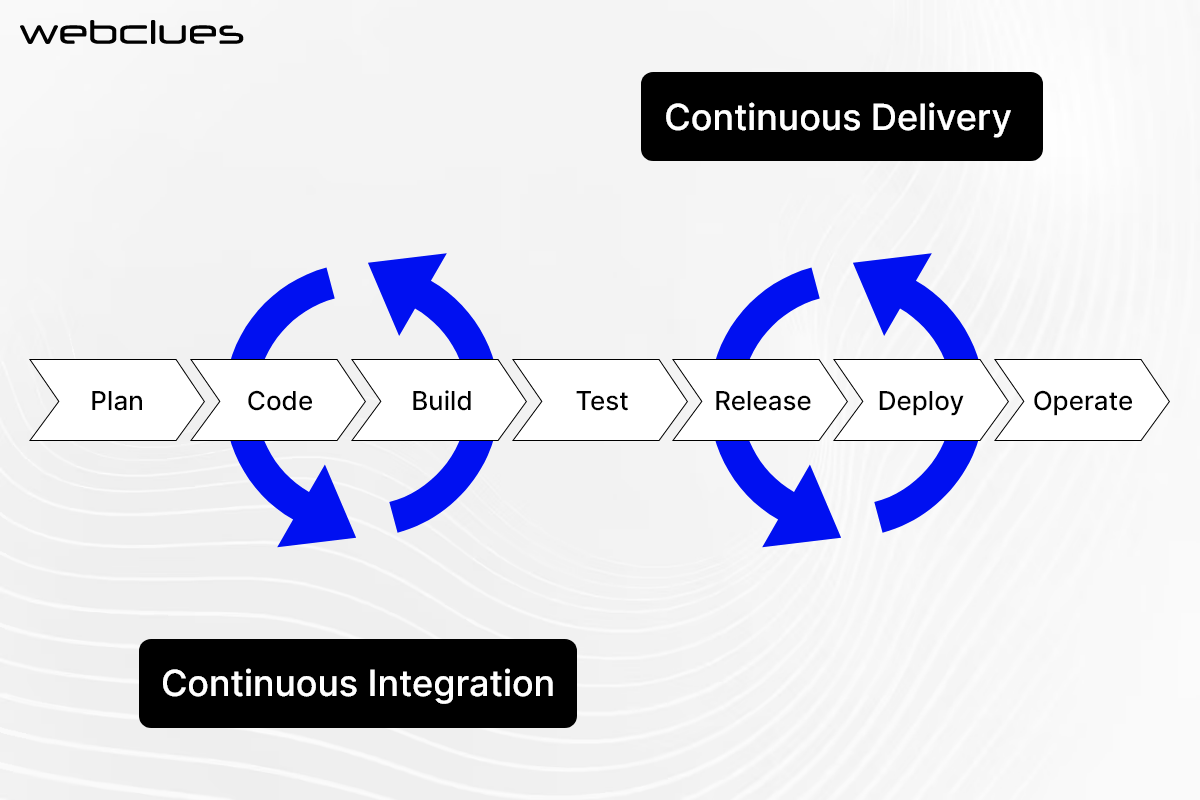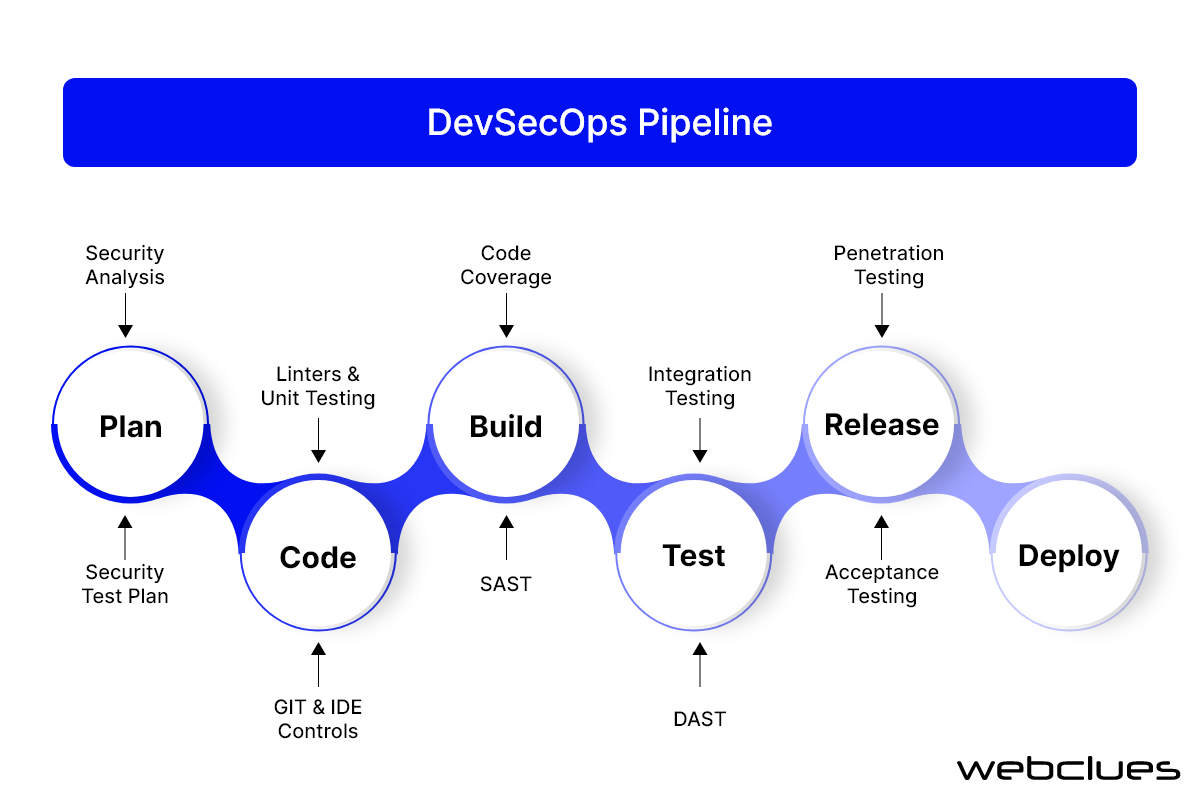Cloud-Native DevOps: Harnessing the Power of Cloud Computing for Agile Software Development

Businesses providing software solutions face unprecedented challenges to deliver innovation and stay competitive in today’s continuously evolving digital landscape. Agility, speed, efficiency, and scalability are essential for organizations to thrive in such a dynamic environment. Enter Cloud-Native DevOps, a transformative paradigm that revolutionizes software development and deployment by bringing together the best of both cloud computing and DevOps practices. This blog post will walk you through the concept of Cloud-Native DevOps and will shed light on how it empowers teams at software development companies to quickly and seamlessly adapt to market demands, optimize resource utilization, and drive business growth.
Understanding Cloud-Native DevOps
Cloud-Native DevOps refer to a set of practices that include ongoing improvement, automation, cross-functional teams, and better alignment with business needs, keeping customer expectations in mind. Instead of focusing on where the application or software is hosted – be it on the cloud or on-premises, these principles are focused on improving how the software is developed and delivered. In other words, they apply to people, tools, culture, and processes involved in software development, irrespective of where the application is hosted. Essentially, Cloud-Native DevOps is a solution to speed up your business and a method to structure your teams to leverage the automation and scalability that cloud-native application development technologies like containers and Kubernetes offer.
How Cloud Computing Aids Agile Software Development
Cloud computing is one of the cornerstones of agile software development, offering several advantages that enhance the development process and propel business outcomes. Here’s how cloud computing plays a key role in agile software development.
-: Scalability and flexibility
When it comes to offering scalability and flexibility in terms of software development there is hardly anything that matches cloud computing. Cloud platform capabilities like auto-scaling enable the dynamic allocation of resources based on traffic and demand. This guarantees consistent performance during peak periods as well as cost optimization during periods of low activity. By enabling a rapid upscaling or downscaling of resources, cloud computing helps businesses to adapt quickly to changing requirements and handle traffic spikes efficiently.
Furthermore, microservices architecture and containerization offer tremendous scalability while designing cloud-native applications. Microservices refer to small, independent components that work hand-in-hand to make up an application. This design makes adapting to varying workloads more straightforward as it becomes possible to deploy and scale each microservice independently. At the same time, containers such as Docker further boost scalability by providing a lightweight and consistent environment for running these microservices.
-: Cost Optimization and Resource Efficiency
One of the key benefits of adopting the cloud-native approach is that it reduces reliance on physical infrastructure. With cloud service providers offering a pay-as-you-go model, software development companies need to pay only for the resources they consume. This cost-effective model is the best fit for startups as well as established enterprises as it minimizes upfront expenses. It offers additional peace of mind with cloud providers optimally managing and utilizing resources and ensuring less wastage.
Another cloud-native technology that takes resource efficiency to the next level is serverless computing. It involves breaking down applications into smaller functions, which are executed as required. It takes the burden of provisioning and managing servers off the developers’ shoulders and allows them to focus solely on writing code while the cloud providers automatically handle the underlying infrastructure. This reduces costs and at the same time helps developers build highly responsive and scalable applications.
-: Continuous Integration & Continuous Delivery (CI/CD)
Continuous Integration and continuous delivery (CI/CD) is an iterative approach that aims to improve development cycles, accelerate time-to-market, and enhance overall product quality. Embracing the principles of CI/CD lets Cloud-Native DevOps effectively streamline the development and deployment process. Continuous Integration comprises automatically integrating the code changes into a shared repository, allowing proactive detection and resolution of integration issues. Continuous delivery involves releasing new features and updates rapidly and reliably by automating the deployment process.
There is a wide range of tools and services that organizations use to effectively implement CI/CD in a cloud-native environment. For instance, version control systems like Git let developers efficiently collaborate on code changes. Tools like Jenkins or GitLab CI/CD are used to build CI/CD pipelines that automate the process of building, testing, and deploying code changes to various environments. Moreover, cloud providers can further simplify the setup and management of CI/CD workflows by offering managed services for CI/CD, such as AWS CodePipeline and Google Cloud Build.
-: Improved Collaboration and Communication
One of the most important aspects of DevOps solutions and services is effective collaboration and communication between development and operations teams. Cloud-based development environments complement this aspect of DevOps culture by facilitating the breakdown of traditional silos and fostering a culture of shared responsibility. Collaborative tools and shared access to cloud resources help teams solve problems faster and reduce development bottlenecks.
With the rise of remote work and globally distributed teams, collaboration in software development has become more crucial than ever before. Numerous cloud-based collaboration tools have gained considerable traction, enabling real-time communication, sharing of updates, and progress tracking. Here are a few examples:
- Slack
- Microsoft Teams
- Jira
Furthermore, by providing a centralized repository for code, documentation, and project management, cloud-native application development platforms offer consistent access to the latest information.
Latest Advancement in Cloud-Native DevOps
Cloud-Native DevOps has seen numerous developments in recent times with the evolution of the technology landscape. Some of the noteworthy advancements in the field are explored below.
-: Serverless Computing
Serverless computing or Function as a Service (FaaS) has come as a significant development in Cloud-Native DevOps. By encouraging modular development, the serverless architecture allows developers to build smaller, specialized functions that are easy to manage and deploy. Serverless computing is known for its event-driven nature, wherein functions are executed in response to events, such as HTTP requests, database changes, or file uploads. Such an architecture leads to a seamless and responsive user experience by allowing applications to respond dynamically to user interactions.
-: Kubernetes and Containerization
Containerization is one of the core concepts of cloud-native application development. The key benefit of containers is that they make it easy to deploy and run applications consistently across different environments. They accomplish this by enclosing an application and its dependencies together. This way, containers allow more than one application to run on the same host with interference by offering isolation and resource efficiency.
Kubernetes, a powerful container concentration platform, builds on the benefits of containerization. It ensures applications' high availability and resiliency by automating container deployment, scaling, and self-healing, thus acting as a robust platform for managing containers at scale. Kubernetes further makes it simpler to build and maintain cloud-native applications by offering features like secure discovery, load balancing, and auto-scaling.
-: Infrastructure as Code (IaC)
Infrastructure as Code (IaC) is one of the latest practices in Cloud-Native DevOps that lets developers define infrastructure management in code, treating infrastructure management as software development. By providing them with the ability to provision, configure, and manage resources programmatically, the approach optimizes the process of setting up development and product environment. This way, IaC minimizes human errors and improves human error, and boosts the overall stability of cloud-native applications.
There are several IaC tools available to define infrastructure as code declaratively. Terraform and AWS CloudFormation are the most prominent among them. These tools automatically provision and configure required resources when developers describe the desired state of their infrastructure using configuration files. As a result, it becomes easier to develop a reproducible, version-controlled, and easily auditable infrastructure.
Furthermore, adopting IaC reduces the risk of configuration drift and ensures a stable and secure cloud-native environment.
-: Edge Computing
Edge Computing has come up as revolutionary development for applications requiring real-time processing like Internet of Things (IoT) devices, augmented reality (AR), and smart cities. This is because edge computing involves deploying applications and services closer to the end-users or edge devices, making it a suitable fit for scenarios where low latency and high bandwidth are crucial. For instance, edge computing can help autonomous vehicles process sensor data in real-time and allow them to make instant decisions without depending on a central cloud server. Similarly, in industrial IoT applications, by facilitating on-site data and analysis, edge computing can minimize the need to transmit large amounts of data to a remote cloud server.
Implementation of edge computing in a cloud-native environment requires organizations to consider factors like application design, data synchronization, and security. Edge computing uses cases can be supported by cloud-native technologies like Kubernetes as it can provide a combined platform to manage applications across both cloud and edge environments.
-: DevSecOps
DevSecOps is technically an extension of DevOps practices that aims to integrate security into the development process. It is critical to incorporate security throughout the software development lifecycle considering the ever-evolving cybersecurity landscape. DevSecOps reduces the risk of security breaches and data leaks by enabling organizations to identify and mitigate vulnerabilities early in the development process. DevSevOps makes sure that applications meet the highest security standards through practices, such as automated security testing, code analysis, and continuous monitoring.
DevSecOps advocates for the responsibility of security shared across all three teams – development, operations, and security. The approach makes security a fundamental aspect of cloud-native development, integrating security considerations into the CI/CD pipeline, thus ensuring security checks are performed automatically during the development process.
Furthermore, services from cloud providers for identity and access management, encryption, network security, and threat detection can be seamlessly integrated into cloud-native applications and play an essential role to implement DevSecOps effectively.
-: Service Mesh with Microservices
As the adoption of microservices architecture is growing, service mesh technology has become substantially popular in cloud-native environments. A service mesh enhances the observability, reliability, and security of microservices by providing a dedicated infrastructure layer that handles service-to-service communication. This way, it lets developers offload critical networking responsibilities from individual services to the mesh infrastructure. With centralized control, they can focus better on business logic and application features, making the development and maintenance of cloud-native applications simpler.
Moreover, to cope with the increasing complexity of microservices architectures and address the resultant difficulty in managing service-to-service communication, the service mesh sits alongside the microservices, intercepting and managing communication traffic between them.
Essentially service meshes offer hoards of benefits for cloud-native applications by offering numerous features like service discovery, load balancing, circuit breaking, and distributed tracing, along with enforcing security policies, encrypting communication, and preventing unauthorized access.
How We Can Help You Embrace the Future of Agile Software Development
Cloud-Native DevOps has come as a revolution in software development, letting businesses adapt quickly to market changes, innovate rapidly, and deliver top-quality software products at a remarkable speed. It has become crucial for organizations to embrace the advancement in Cloud-Native DevOps and continuously refine the corresponding practices to position themselves for long-term success and growth in this increasingly competitive and fast-paced digital world.
Cloud-Native DevOps is the future of agile software development. So leveraging DevOps and Cloud based services from a trusted software development company can let your organization soar to new heights of efficiency, innovation, and customer satisfaction. With our innovative DevOps solutions and services combined with agile cloud-native application development services, we at WebClues, can help you unlock your maximum potential and make your mark in the digital revolution. Connect with us today, to learn more about our Cloud-Native DevOps solutions.
Build Your Agile Team
Hire Skilled Developer From Us
Achieve your cloud goals faster & easier with our Cloud-Native DevOps Solutions
We help you adopt a cloud-native approach to develop secure & scalable applications, along with end-to-end support - from planning & architecture to development & deployment.
Get In Touch Now!Our Recent Blogs
Sharing knowledge helps us grow, stay motivated and stay on-track with frontier technological and design concepts. Developers and business innovators, customers and employees - our events are all about you.
Contact Information
Let’s Transform Your Idea into Reality - Get in Touch
India
Ahmedabad
1007-1010, Signature-1,
S.G.Highway, Makarba,
Ahmedabad, Gujarat - 380051
Rajkot
1308 - The Spire, 150 Feet Ring Rd,
Manharpura 1, Madhapar, Rajkot, Gujarat - 360007
UAE
Dubai
Dubai Silicon Oasis, DDP,
Building A1, Dubai, UAE
USA
Delaware
8 The Green, Dover DE, 19901, USA
New Jersey
513 Baldwin Ave, Jersey City,
NJ 07306, USA
California
4701 Patrick Henry Dr. Building
26 Santa Clara, California 95054
Australia
Queensland
120 Highgate Street, Coopers Plains, Brisbane, Queensland 4108
UK
London
85 Great Portland Street, First
Floor, London, W1W 7LT
Canada
Burlington
5096 South Service Rd,
ON Burlington, L7l 4X4





